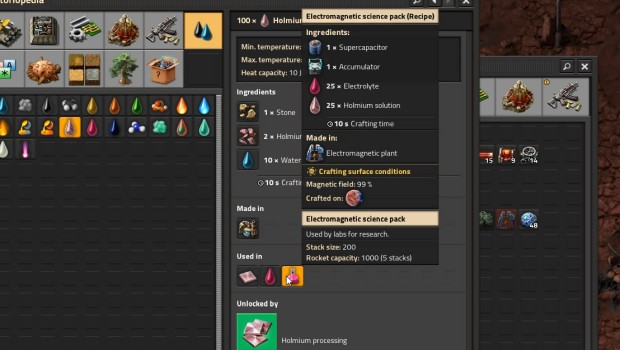It took the combined efforts of around 400,000 people to get the first man onto the Moon, so it's understandably a bit daunting when Factorio's new Space Age expansion asks you to start up an interstellar empire all on your own. Thankfully, Factorio does a pretty good job of breaking down super complicated tasks into manageable chunks, as well as automating much of the tedious stuff. With just a little bit of preparation it's entirely possible to make your first journey across the stars a nice and smooth one.
So in order to help you out, I would like to share with you a list of things that I had to learn the hard way and wish I knew from the very start. These aren't going to be ideal build orders or tricks to hyper optimize your base as I'm by no means a Factorio expert, but rather simple advice to help you prioritize the important stuff and avoid many of the pitfalls I fell into head-first. And without further ado, let us begin!
Video version of this guide (~15 minutes)
1) Supersize and automate
In vanilla Factorio it's entirely possible to beat the game in a reasonable amount of time while only having a small base with a small throughoutput. In Space Age, however, this is a road that leads straight to madness. The process of getting everything you need to be self-sufficient on an alien planet simply requires far more materials and products than a couple of random level 1 assembling machines will be able to provide.
As such, you'll need to supersize and automate your base. Clear out any biters in outlying areas, establish mining outposts and train networks connecting them to your main base, and ensure you're able to automatically create whatever buildings or tools your base might need. This might sound excessive now, but once you're on the other end of the solar system and your base suffers an attack, having it capable of rebuilding itself without direct intervention will be a godsend.
Oh, and speaking of defense, you can remotely pilot vehicles regardless of where in the galaxy you are. So if biters have found a crack in your defenses and are now chewing on your production line, just assume direct control of a tank and pay them a quick visit.

Do be warned - your vision will be limited by your radar's area of effect
2) Overpack and overprepare
I'm a very lazy person, and so in vanilla Factorio I often traveled light and hand-crafted any specialized items I might need in a pinch. In Space Age this terrible habit made me lose literal hours as I was forced to gather everything I need to construct machinery from scratch on an alien world - essentially dooming myself to 'restart' the game because of my haphazard planning.
Because of this, I would highly recommend you overprepare and overpack for your journey to a new planet lest you end up like me. Pack a bunch of advanced items you might need to construct high tier buildings, as well as a boatload of basic stuff like belts, underground belts, pipes, power poles, inserters, assemblers, furnaces, bots and so forth. You can also consider bringing with you all of the lighter items you'll need to construct a rocket silo so you'll always have a way back, though this is by no means necessary as once your new base is fully operational it doesn't take much to start launching rockets.

You can never have too much stuff
3) More guns? Always!
At some point while building your space platform the game will tell you about asteroids and how turrets can be used to reduce them to a more manageable size. What Factorio doesn't tell you is that traveling to a new planet will have you go straight through an incredibly thick asteroid field! Depending on the size of your ship it's not out of the question to expect at least 4-5 chunky asteroids to be threatening you at any given moment.
So before you even consider making the trip to a new world, make sure to staple a decent amount of gun turrets to your space platform - and they specifically have to be gun turrets as those are the most effective for the first leg of your journey.
You'll also need to automate ammo production directly on the space platform as you simply can't afford to launch it from your base given that Factorio ammo is surprisingly heavy and thus expensive to transport. And finally, don't forget to upgrade your gun turrets with research! I skipped this part because I was rushing to get to all of the juicy space stuff, which in hindsight was a horrible mistake that made my first few trips a lot sketchier than they needed to be.

I went a bit overboard, but turrets are cheap so might as well
4) When in doubt, Alt + Left Click
Factorio has a lot of items that require all sorts of different ingredients and production facilities which makes it very easy to get confused about how to achieve certain goals. Thankfully, Factorio also has an incredibly detailed in-game wiki that covers everything you might need to know about each individual item or building.
To access it you simply have to Alt + Left Click on whatever item you're interested. This will open up a new window that will tell you where that item can be found, all the different ways it can be created, and perhaps most importantly of all, everything it can be used for. That last part was a real lifesaver for me because it helped guide me down the intended progression path on each of the alien worlds. So if you're ever stuck, consult the wiki and see what sort of stuff you might be able to make with the ingredients around you, and chances are the solution will jump right at you.

Hats off to whoever made the in-game wiki. They really are a lifesaver!
5) Save early, save often
When I said I was essentially forced to restart the game because I was lazy, I wasn't joking. If you're not careful you can get stuck on an alien planet for a dozen hours or more due to a lack of crucial resources. While I personally didn't mind this too much since a little bit of adversity makes for interesting storytelling, it's definitely not the kind of approach I'd recommend you take.
Same thing with asteroids. It's very easy to think you're prepared to travel only to discover a major vulnerability in your design while in the depths of space surrounded by deadly rocks. I should know! It happened to me three times in a row!
So in order to avoid a grizzly or even simply an annoying fate, make sure to save every single time you're making a big move. It only takes a couple of seconds, yet it can save you hours as you'll always be able to rewind failed experiments or poorly thought out expeditions. If you're feeling brave you can also rely on autosaves, though I wouldn't recommend it as sometimes it takes a good 15-20 minutes to realize just how boned you truly are.

As it turns out, laser turrets are pretty bad against asteroids
6) Quality and quantity
Quality is a new mechanic introduced with Space Age that sounds complicated, but is actually fairly simple and extremely useful. By inserting a quality module into any production facility you'll have a small chance to create a higher quality product. And since Factorio is a game where everything is done in massive numbers, this small chance means you'll be getting a ton of quality products over time. These improved items can be significantly stronger, healthier, faster or easier to use than their basic variants, and this even applies to key items like rocket silos, player armor and assemblers.
So how do you get the good stuff? Easy. Use quality modules on buildings producing basic ingredients like steel and copper plates, and then filter the results out from your usual production queue. This is very important because different quality ingredients don't mix. Everything has to be of the same tier.
Then, once you have high quality base ingredients you can use those to create guaranteed high quality results. My advice would be to automate production of frequently used buildings like assemblers or furnaces to greatly speed up your base, and then 'manually' build big ticket items that you'll only need once or twice.

Results after a very brief production test (140 normal, 13 uncommon and 1 rare items)
7) Free shipping
While space platforms cost a fair bit of resources to create, they are completely self-sufficient once operational. This means that sending things between worlds is actually surprisingly easy. The entire cost is in the rockets you'll have to send up to fill up the space platform - the shipping itself is free!
As such, I would highly recommend creating multiple space platforms and using those to send lighter resources and key items between worlds: stuff like electromagnetic plants from Fulgora and calcite or foundries from Vulcanus. Similarly, I'd highly recommend creating a stationary platform in Nauvis' orbit whose sole purpose is to provide white science for the labs below.

Trains are also very cheap, so don't forget to use them!
8) Basic circuitry
While you can squeeze through the base version of Factorio without dipping your feet into circuitry, trying to do that in Space Age will be a massive pain in the butt cheeks. Between items that spoil on Gleba and new production facilities that create heaps of garbage, both in space and on land, there is a very clear need for simply circuitry to keep things neat and tidy. Don't worry, however, you don't have to do anything super complicated. Just the basics!
The easiest and most commonly applicable example is going to be linking an inserter or assembly machine with a storage box. Look at the bottom right of your HUD or press Alt + G to access one of your three unique wire colors - green in this case. Connect the assembly machine with the chest, and then clear your selection so you don't accidentally wire up anything else. If you do connect something by accident, simply connect it up again and it'll delete the wire.
Once you've done this you can click on the assembly machine and in the top right of its menu select "Circuit Network". Enable it and then in the menu immediately below it set the conditions you want to track. For example, you can make it so the assembly machine is active while you have less than 1000 pieces of ammo in storage, after which it'll disable itself. This way you can have continuous ammo production on a space platform without worrying about it overwhelming your storage. And that's it!
From here you can move onto more advanced stuff like tracking multiple ingredients, but that's a problem you can tackle slowly over time as the basics I mentioned will help you keep everything running until you're ready to take the next step.

It looks intimidating, but basic circuitry is super easy to figure out
9) What planet to go to first?
Once you're ready to travel between the stars you'll have to choose between three unique planets: Gleba, Fulgora and Volcanus. Since this is a big investment of time and resources, you're probably wondering which one if the best? Well, the good news is that Factorio actually balanced them fairly well so you can start wherever you want without messing yourself up. They all give you something powerful.
That said, I would still recommend either Fulgora or Vulcanus as your first stop. Fulgora will give you a large amount of electronic goods, a mech suit, as well as the ability to create electronics in a significantly more efficient way. The one downside is that you'll have to spend a bit of time thinking about how to handle recyclers and the endless mountains of random garbage that they spew out. It's a nice challenge, but it's definitely a bit of a hassle.
Vulcanus on the other hand produces a frankly insane amount of resources and allows you to transport that technology back to your home base. This overabundance of resources is also really handy for building space platforms, which makes it a particularly good place to create a trade fleet that will ship important supplies from one end of the system to another. This is the one I started on, and aside from some early difficulties due to poor planning, I had a pretty good time with it.
As for Gleba, that is definitely the most challenging of the starter planets. Gleba has a completely unique production chain that revolves around managing heaps of resources that rot in real time, which means that any mishap in the production chain will stop everything and force you to manually purge the junk and restart. So despite it being my favorite, I'd leave Gleba for last and focus on the more 'traditional' planets first. They're both great options.

Gleba is as beautiful as it is deadly
Closing thoughts
There you have it, nine simple tips that will hopefully make your first time with Factorio: Space Age nice and pleasant. That said, Factorio is a very complicated game and even when you know exactly what to do and how to do it, it's still very easy to mess up and have to redo your entire plan.
So if you ever find yourself stumbling, don't worry about it! We've all been there. It doesn't matter if it takes you 30 hours or 300 hours to complete everything. As long as you're enjoying the journey that's all that really matters since Factorio, at its core, is all about trying, failing, learning from your mistakes and then coming back stronger than ever!














